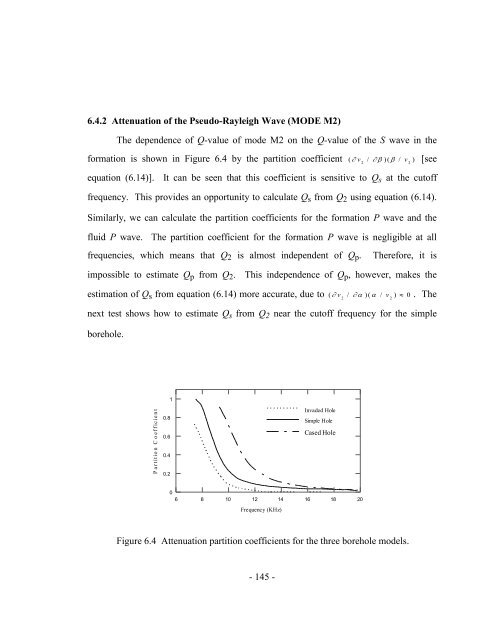My PhD Thesis, PDF 3MB - Stanford University
My PhD Thesis, PDF 3MB - Stanford University
My PhD Thesis, PDF 3MB - Stanford University
You also want an ePaper? Increase the reach of your titles
YUMPU automatically turns print PDFs into web optimized ePapers that Google loves.
6.4.2 Attenuation of the Pseudo-Rayleigh Wave (MODE M2)<br />
The dependence of Q-value of mode M2 on the Q-value of the S wave in the<br />
formation is shown in Figure 6.4 by the partition coefficient ( v 2 / )( / v 2 ) [see<br />
equation (6.14)]. It can be seen that this coefficient is sensitive to Qs at the cutoff<br />
frequency. This provides an opportunity to calculate Qs from Q2 using equation (6.14).<br />
Similarly, we can calculate the partition coefficients for the formation P wave and the<br />
fluid P wave. The partition coefficient for the formation P wave is negligible at all<br />
frequencies, which means that Q2 is almost independent of Qp. Therefore, it is<br />
impossible to estimate Qp from Q2. This independence of Qp, however, makes the<br />
estimation of Qs from equation (6.14) more accurate, due to ( v 2 / )( / v 2 ) 0 . The<br />
next test shows how to estimate Qs from Q2 near the cutoff frequency for the simple<br />
borehole.<br />
P a r t it io n C o e f f ic ie n t<br />
0.8<br />
0.6<br />
0.4<br />
0.2<br />
1<br />
0<br />
6 8 10 12 14 16 18 20<br />
Frequency (KHz)<br />
- 145 -<br />
Invaded Hole<br />
Simple Hole<br />
Cased Hole<br />
Figure 6.4 Attenuation partition coefficients for the three borehole models.
















